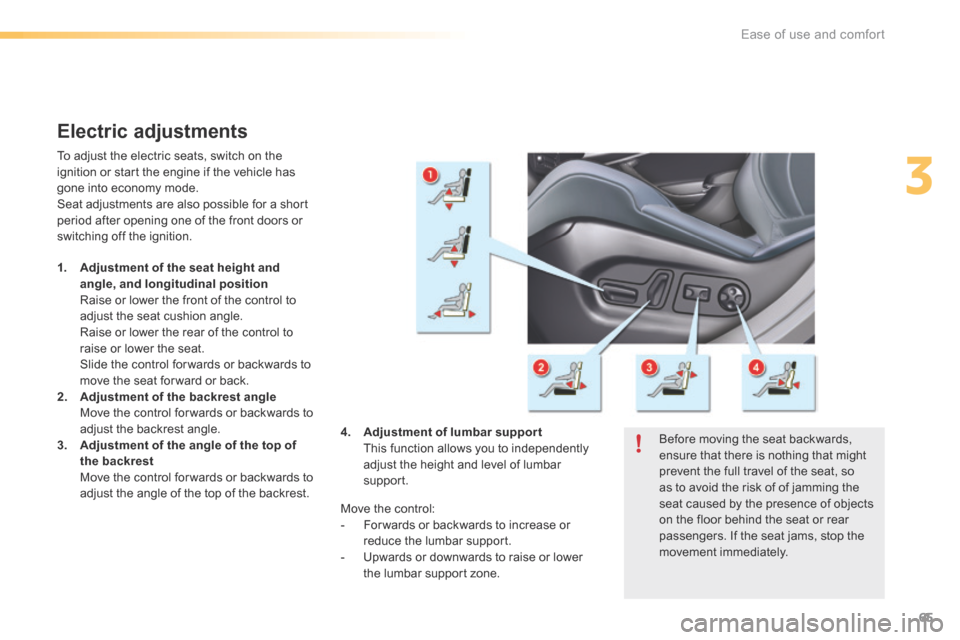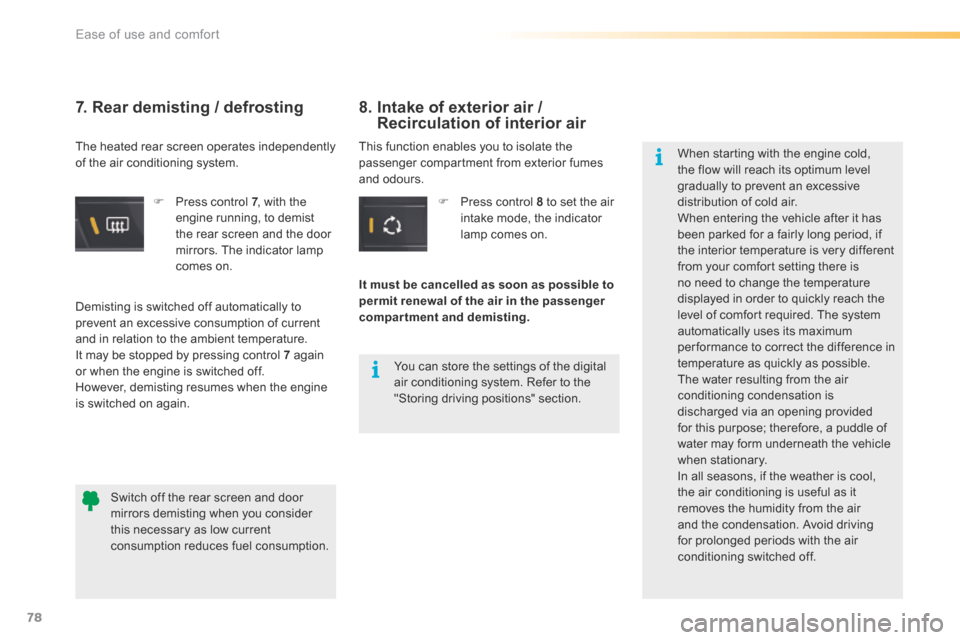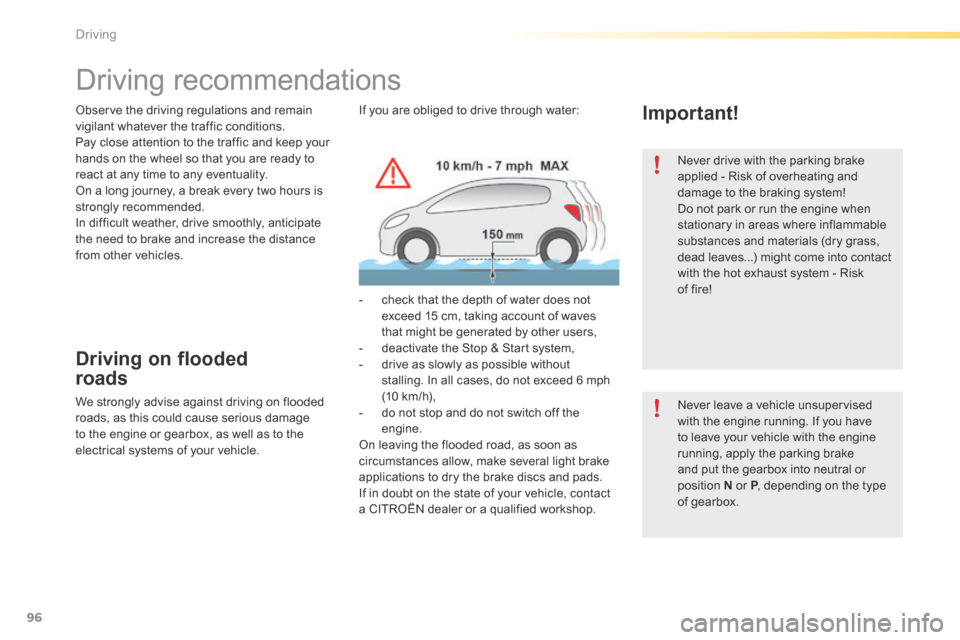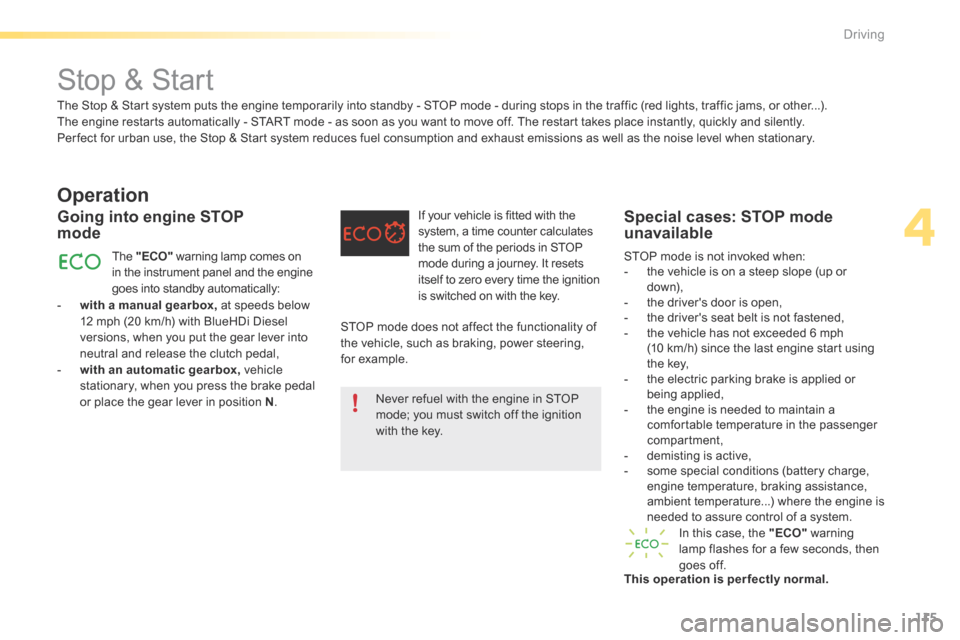stop start Citroen C5 2016 (RD/TD) / 2.G User Guide
[x] Cancel search | Manufacturer: CITROEN, Model Year: 2016, Model line: C5, Model: Citroen C5 2016 (RD/TD) / 2.GPages: 366, PDF Size: 30.93 MB
Page 51 of 366

49
C5_en_Chap02_ouverture_ed01-2015
Lost keys
Go to a CITROËN dealer with the vehicle's registration document, your personal
identification documents and if possible the key code label.
The CITROËN dealer will be able to look up the key code and the transponder code
required to order a new key.
Remote control
The high frequency remote control is a sensitive system; do not operate it while it is in your
pocket as there is a possibility that it may unlock the vehicle, without you being aware of it.
Do not repeatedly press the buttons of your remote control out of range and out of sight of
your vehicle. You run the risk of stopping it from working and the remote control would have
to be reinitialised.
No remote control can operate when the key is in the ignition switch, even when the ignition
is switched off, except for reinitialisation.
Locking the vehicle
Driving with the doors locked may make access to the passenger compartment by the
emergency services more difficult in an emergency.
As a safety precaution, never leave children alone in the vehicle, except for a very short
period.
In all cases, it is essential to remove the key from the ignition switch when leaving the vehicle.
Anti-theft protection
Do not make any modifications to the electronic engine immobiliser system; this could
cause malfunctions.
When purchasing a second-hand vehicle
Have the pairing of all of the keys in your possession checked by a CITROËN dealer, to
ensure that only your keys can be used to open and start the vehicle.Do not throw the remote control
batteries away, they contain metals
which are harmful to the environment.
Take them to an approved collection
point.
2
access
Page 67 of 366

65
C5_en_Chap03_ergo-et-confort_ed01-2015
Electric adjustments
To adjust the electric seats, switch on the
ignition or start the engine if the vehicle has
gone into economy mode.
Seat adjustments are also possible for a short
period after opening one of the front doors or
switching off the ignition.
1. Adjustment of the seat height and
angle, and longitudinal position
Raise or lower the front of the control to
adjust the seat cushion angle.
Raise or lower the rear of the control to
raise or lower the seat.
Slide the control for wards or backwards to
move the seat for ward or back.
2. Adjustment of the backrest angle
Move the control for wards or backwards to
adjust the backrest angle.
3. Adjustment of the angle of the top of
the backrest
Move the control for wards or backwards to
adjust the angle of the top of the backrest. Before moving the seat backwards,
ensure that there is nothing that might
prevent the full travel of the seat, so
as to avoid the risk of of jamming the
seat caused by the presence of objects
on the floor behind the seat or rear
passengers. If the seat jams, stop the
movement immediately.
Move the control:
-
For wards or backwards to increase or
reduce the lumbar support.
- Upwards or downwards to raise or lower
the lumbar support zone.
4.
Adjustment of lumbar support
This function allows you to independently
adjust the height and level of lumbar
support.
3
Ease of use and comfort
Page 79 of 366

77
C5_en_Chap03_ergo-et-confort_ed01-2015
With Stop & Start, when demisting has
been activated, the STOP mode is not
available.
Switching off the ventilation
F Turn control 5 to the left until
the flow of air stops.
5. Air flow adjustment
F Turn control 5 to the right to
increase the air flow or to the
left to reduce it.
6. Front demisting / defrosting
In certain cases, the "AUTO"
mode may not be sufficient to
demist or defrost the windows
(humidity, several passengers,
i c e).
The "OFF" symbol is displayed in the display screen.
This action switches off the screen and the indicator
lamps.
It deactivates all of the system's functions, with the
exception of the rear screen demisting.
The temperature-related comfort is no longer controlled
(temperature, humidity, odour, condensation).
Avoid driving for too long with the air conditioning off.The air flow level is indicated by the
progressive illumination of the bars in the
control panel screen 9 .
To prevent condensation and deterioration
of the quality of the air in the passenger
compartment, ensure that an adequate flow of
air is maintained.
To reactivate the air conditioning:
F Press control 1 . F
Press control 6 to clear the windows
quickly. The indicator lamp comes on.
The "Demisting" mode controls the
temperature, air flow and intake and distributes
the ventilation to the windscreen and front side
windows.
Resuming manual control exits from
"Demisting" mode. It must be cancelled to
permit renewal of the air in the passenger
compartment and demisting.
Once the screen is clear, pressing control 1
returns the system to "AUTO" mode.
3
Ease of use and comfort
Page 80 of 366

78
C5_en_Chap03_ergo-et-confort_ed01-2015
F Press control 7 , with the
engine running, to demist
the rear screen and the door
mirrors. The indicator lamp
comes on.
7. Rear demisting / defrosting
This function enables you to isolate the
passenger compartment from exterior fumes
and odours.
Switch off the rear screen and door
mirrors demisting when you consider
this necessary as low current
consumption reduces fuel consumption. F
Press control 8 to set the air
intake mode, the indicator
lamp comes on.
Demisting is switched off automatically to
prevent an excessive consumption of current
and in relation to the ambient temperature.
It may be stopped by pressing control 7 again
or when the engine is switched off.
However, demisting resumes when the engine
is switched on again. It must be cancelled as soon as possible to
permit renewal of the air in the passenger
compartment and demisting.
The heated rear screen operates independently
of the air conditioning system.
You can store the settings of the digital
air conditioning system. Refer to the
"Storing driving positions" section.When starting with the engine cold,
the flow will reach its optimum level
gradually to prevent an excessive
distribution of cold air.
When entering the vehicle after it has
been parked for a fairly long period, if
the interior temperature is very different
from your comfort setting there is
no need to change the temperature
displayed in order to quickly reach the
level of comfort required. The system
automatically uses its maximum
per formance to correct the difference in
temperature as quickly as possible.
The water resulting from the air
conditioning condensation is
discharged via an opening provided
for this purpose; therefore, a puddle of
water may form underneath the vehicle
when stationary.
In all seasons, if the weather is cool,
the air conditioning is useful as it
removes the humidity from the air
and the condensation. Avoid driving
for prolonged periods with the air
conditioning switched off.
8.
Intake of exterior air /
Recirculation of interior air
Ease of use and comfort
Page 84 of 366

82
C5_en_Chap03_ergo-et-confort_ed01-2015
9. Front demisting / defrosting
In certain cases, the "AUTO"
mode may not be sufficient to
demist or defrost the windows
(humidity, several passengers,
i c e).
8. Rear demisting / defrosting
The heated rear screen operates
independently of the air
conditioning system.
F Press control 8 , with the engine running, to
demist the rear screen and the mirrors. The
indicator lamp comes on.
Demisting is switched off automatically to
avoid excessive consumption of current and
depending on the exterior temperature.
It may be stopped by pressing control 8 again
or when the engine is switched off.
In this latter case, the demisting resumes if the
engine is switched on again within one minute. F
Press control 9 to clear the windows
quickly. The indicator lamp comes on.
This system controls the temperature, air flow
and intake and distributes the ventilation to the
windscreen and front side windows.
Resuming manual control exits from the
"Demisting" mode. It must be cancelled as
soon as possible to permit renewal of the air in
the passenger compartment and demisting.
Pressing one of the controls 1a or 1b returns
the system to the "AUTO" mode.
With Stop & Start, when demisting has
been activated, the STOP mode is not
available. When starting with the engine cold,
air flow will reach its optimum level
gradually to prevent an excessive
distribution of cold air.
When entering the vehicle after it has
been parked for a fairly long period, if
the interior temperature is very different
from your comfort setting there is
no need to change the temperature
displayed in order to quickly reach the
level of comfort required. The system
automatically uses its maximum
per formance to correct the difference in
temperature as quickly as possible.
The water resulting from the air
conditioning condensation is
discharged via an opening provided
for this purpose; therefore, a puddle of
water may form underneath the vehicle
when stationary.
In all seasons, if the weather is cool,
the air conditioning is useful as it
removes the humidity from the air
and the condensation. Avoid driving
for prolonged periods with the air
conditioning switched off.
Switch off the rear screen and
exterior mirrors demisting when you
consider this necessary as low current
consumption reduces fuel consumption.
Ease of use and comfort
Page 98 of 366

96
C5_en_Chap04_conduite_ed01-2015
Observe the driving regulations and remain
vigilant whatever the traffic conditions.
Pay close attention to the traffic and keep your
hands on the wheel so that you are ready to
react at any time to any eventuality.
On a long journey, a break every two hours is
strongly recommended.
In difficult weather, drive smoothly, anticipate
the need to brake and increase the distance
from other vehicles.
Driving on flooded
roads
We strongly advise against driving on flooded
roads, as this could cause serious damage
to the engine or gearbox, as well as to the
electrical systems of your vehicle.
Driving recommendations
Important!
Never drive with the parking brake
applied - Risk of overheating and
damage to the braking system!
Do not park or run the engine when
stationary in areas where inflammable
substances and materials (dry grass,
dead leaves...) might come into contact
with the hot exhaust system - Risk
of fire!
n ever leave a vehicle unsupervised
with the engine running. If you have
to leave your vehicle with the engine
running, apply the parking brake
and put the gearbox into neutral or
position N or P, depending on the type
of gearbox.
If you are obliged to drive through water:
-
check that the depth of water does not
exceed 15 cm, taking account of waves
that might be generated by other users,
- deactivate the Stop & Start system,
- drive as slowly as possible without
stalling. In all cases, do not exceed 6 mph
(10 km/h),
- do not stop and do not switch off the
engine.
On leaving the flooded road, as soon as
circumstances allow, make several light brake
applications to dry the brake discs and pads.
If in doubt on the state of your vehicle, contact
a CITROËN dealer or a qualified workshop.
driving
Page 99 of 366

97
C5_en_Chap04_conduite_ed01-2015
Anti-theft protection
Electronic engine immobiliser
The key contains an electronic chip which has
a special code. When the ignition is switched
on, this code must be recognised in order for
starting to be possible.In the event of a fault, you are
informed by illumination of this
warning lamp, an audible signal and
a message in the screen.
In this case, your vehicle will not start; contact
a CITROËN dealer as soon as possible.
Starting-switching off the engine
Keep safely, away from your vehicle,
the label attached to the keys given to
you on acquisition of the vehicle.
Ignition switch
It has 3 positions:
- position 1 (Stop): insert and removing
the key,
- position 2 (Ignition on) : steering column
unlocked, ignition on, Diesel preheating,
engine running,
- position 3 (Starting).
Ignition on position
It allows the use of the vehicle's electric
equipment or portable devices to be charged.
Avoid attaching heavy objects to the
key or the remote control, which would
weigh down on its blade in the ignition
switch and could cause a malfunction.
It could adversely affect the deployment
of the front airbag.
This electronic engine immobiliser locks the
engine management system a few moments
after the ignition is switched off and prevents
starting of the engine by anyone who does not
have the key.
Once the state of charge of the battery drops
to the reserve level, the system switches to
energy economy mode: the power supply is
cut off automatically to preserve the remaining
battery charge.
4
Driving
Page 109 of 366

107
C5_en_Chap04_conduite_ed01-2015
SITUATIONCONSEQUENCES
4 Display of messages "
Parking brake faulty" and "Anti
roll-back fault" and of the following warning lamps:
and/or flashing -
The automatic functions are deactivated.
- The hill start assist is not available.
To apply the electric parking brake:
F Immobilise the vehicle and switch off the ignition
F Pull the control lever for at least 5 seconds or until maximum application.
F Switch on the ignition and check that the electric parking brake warning lamps
are on.
- Application may take longer than in normal operation.
- If warning lamp (!) flashes or if the warning lamps do not come on when the
ignition is switched on, this method does not work. Have it checked by a
CITROËN dealer or a qualified workshop.
To release the electric parking brake:
F Switch on the ignition.
F Push the control lever and hold it for approximately 3 seconds.
5 Display of message "
Parking brake control faulty –
automatic mode activated " and the following warning
lamps:
and/or flashing -
Only the functions for automatic application on switching off the engine and
automatic release on acceleration are available.
- Manual application/release of the electric parking brake and dynamic
emergency braking are unavailable.
6 Display of message "
Parking brake faulty " and of the
following warning lamp:
flashing -
Application of the parking brake is not guaranteed.
- The parking brake is temporarily unavailable.
It this situation arises:
F Wait approximately 3 minutes.
F After 3 minutes, if the warning lamp is still flashing, try to reinitialise the parking
brake, either by pushing and releasing the control A while pressing the brake
pedal or by means of a long pull on control lever A .
7 Battery problem
- Illumination of the battery warning lamp makes it essential to stop the vehicle
as soon as traffic allows. Stop and immobilise your vehicle.
- Apply the electric parking brake before switching off the engine.
4
Driving
Page 116 of 366

114
C5_en_Chap04_conduite_ed01-2015
System which reduces fuel consumption by recommending the most appropriate
g e a r.
Depending on the driving situation and your
vehicle's equipment, the system may advise
you to skip one (or more) gear(s). You can
follow this instruction without engaging the
intermediate gears.
The gear engagement recommendations must
not be considered compulsory. In fact, the
configuration of the road, the amount of traffic
and safety remain determining factors when
choosing the best gear. Therefore, the driver
remains responsible for deciding whether or not
to follow the advice given by the system.
This function cannot be deactivated.Example:
- You are in third gear.
- You press the accelerator pedal.
Gear shift indicator*
Operation
With an automatic gearbox, the system
is only active in manual mode.
* Depending on engine. On BlueHDi Diesel 150 versions with manual
gearbox, the system may suggest changing into
neutral so that the engine can go into standby
(STOP mode with Stop & Start), in certain
driving conditions. In this case, N is displayed
in the instrument panel. The information appears in the instrument
panel in the form of an arrow.
On vehicle fitted with a manual gearbox,
the arrow may be accompanied by the gear
recommended.
The system adapts its gear change
recommendation according to the
driving conditions (slope, load, ...) and
the demands of the driver (power,
acceleration, braking, ...).
The system never suggests:
- engaging first gear,
- engaging reverse gear.
- The system may suggest that you engage
a higher gear.
driving
Page 117 of 366

115
C5_en_Chap04_conduite_ed01-2015
Stop & Start
Operation
- with a manual gearbox, at speeds below
12 mph (20 km/h) with BlueHDi Diesel
versions, when you put the gear lever into
neutral and release the clutch pedal,
- with an automatic gearbox, vehicle
stationary, when you press the brake pedal
or place the gear lever in position N .
Going into engine STOP
mode
The "ECO" warning lamp comes on
in the instrument panel and the engine
goes into standby automatically: If your vehicle is fitted with the
system, a time counter calculates
the sum of the periods in STOP
mode during a journey. It resets
itself to zero every time the ignition
is switched on with the key.
Special cases: STOP mode
unavailable
In this case, the "ECO"
warning
lamp flashes for a few seconds, then
goes off.
This operation is perfectly normal. STOP mode is not invoked when:
- the vehicle is on a steep slope (up or
d ow n),
- the driver's door is open,
- the driver's seat belt is not fastened,
- the vehicle has not exceeded 6 mph
(10 km/h) since the last engine start using
the key,
- the electric parking brake is applied or
being applied,
- the engine is needed to maintain a
comfortable temperature in the passenger
compartment,
- demisting is active,
- some special conditions (battery charge,
engine temperature, braking assistance,
ambient temperature...) where the engine is
needed to assure control of a system.
The Stop & Start system puts the engine temporarily into standby - STOP mode - during stops in the traffic (red lights, traffic jams, or other...).
The engine restarts automatically - START mode - as soon as you want to move off. The restart takes place instantly, quickly and silently.
Per fect for urban use, the Stop & Start system reduces fuel consumption and exhaust emissions as well as the noise level when stationary.
STOP mode does not affect the functionality of
the vehicle, such as braking, power steering,
for example.Never refuel with the engine in STOP
mode; you must switch off the ignition
with the key.
4
driving